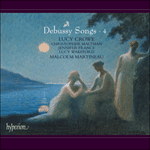Increasingly from the mid-1880s Debussy turned from the elegant Théodore de Banville and from purveyors of sentimentality like Girod and Bourget to poets whose attachments to the Symbolist movement gave him more scope for profundity. In 1882 he made his first two settings of Verlaine, who was to become the poet of some of his greatest songs.
Mandoline is the second of these two, and already at the age of twenty Debussy is seen to be responding to the quality of Verlaine’s writing. The ‘piano-as-mandolin’ was no new concept in French song, but Debussy introduces a new realism both in the opening call to attention, from which a myriad of possible continuations suggest themselves, and in the open fifths that do in fact follow. Now the opening vocal line does not recur until the final verse, allowing Debussy to make a pseudo-rhyme out of ‘chanteuses’ and ‘brises’, both set to a wonderfully floating, chromatic phrase. Purists may disapprove of the final ‘la-la’s, not in Verlaine’s original, but surely what Debussy makes of them disarms criticism? This is the earliest of his characteristic fade-out endings, culminating in a repeat of the opening call to attention, played correctly in this recording, though too rarely elsewhere, with the soft pedal; a wonderful touch, asking ‘Is that it?’. Here for the first time Debussy gave some intimation of what his piano parts would soon become.
from notes by Roger Nichols © 2003
À partir du milieu des années 1880, Debussy se détourna de plus en plus de l’élégant Théodore de Banville et des fournisseurs de sentimentalités comme Girod et Bourget pour des poètes dont les attachements au mouvement symboliste lui ouvrirent de nouveaux horizons pour exprimer des sentiments plus profonds. En 1882, il écrivit ses deux premières réalisations musicales de poèmes de Verlaine qui allait devenir le poète de quelques-unes de ses meilleures mélodies.
Mandoline est la seconde des deux, et dès ses vingt ans, Debussy semble répondre à la qualité d’écriture de Verlaine. Parmi la mélodie française, traiter le «piano comme mandoline» n’était certes pas un concept nouveau, mais Debussy y apporta un réalisme novateur tant dans l’appel initial à l’attention à partir duquel émerge une myriade de continuations possibles que dans les quintes à vide qui s’ensuivent. La ligne vocale initiale ne réapparaît pas avant la strophe finale, permettant à Debussy de réaliser un semblant de rime entre «chanteuses» et «brises», en une phrase musicale merveilleusement flottante et chromatique. Les puristes désapprouveront peut-être les derniers «la la» qui ne figurent pas dans l’original verlainien, mais par sa réalisation, Debussy ne désarme-t-il la critique? Voici la première de ses conclusions idiosyncrasiques qui s’éteignent progressivement; l’intensité culmine dans la reprise de l’appel initial à l’attention, correctement exécuté dans cet enregistrement mais que trop rarement ailleurs, avec la pédale douce: une touche merveilleuse, interrogeant «est-ce donc cela?». Pour la première fois, Debussy laisse préfigurer la manière dont ses parties de piano allaient bientôt sonner.
extrait des notes rédigées par Roger Nichols © 2003
Français: Isabelle Battioni
Seit Mitte der 1880iger Jahre wandte Debussy sich zunehmend vom eleganten Théodore de Banville und den Hütern der feinen Gefühle wie Girot und Bourget ab und widmete sich den Dichtern, deren Verbindung zur Gruppe der Symbolisten ihm mehr Raum für Tiefgründigkeit gab. 1882 schuf er seine ersten zwei Vertonungen auf Gedichte von Verlaine, dessen Texte Debussy einmal zu einigen seiner besten Lieder inspirieren werden.
Mandoline ist das zweiter dieser zwei frühen Verlaine-Lieder, und schon hier sieht man, wie Debussy im Alter von nur mehr 20 Jahren auf den Charakter von Verlaines Gedichten reagiert. Das „Klavier als Mandoline“ war kein neues Konzept im französischen Lied, aber Debussy führt einen neuen Realismus ein, sowohl durch den einleitenden Aufruf, von dem sich eine Vielfalt von möglichen Fortführungen ableiten lassen, und in den offenen Quinten, die tatsächlich dann auch folgen. Danach erscheint die einleitende Melodie der Singstimme bis zur letzten Strophe nicht wieder, wodurch für Debussy die Möglichkeit eines Pseudoreims aus „chanteuses“ und „brises“ entsteht. Beide Wörter werden mit wunderbar fließenden, chromatischen Phrasen vertont. Puristen stimmen vielleicht nicht mit dem anschließenden „la, la“ überein, da es im Gedicht von Verlaine nicht vorkommt, aber sicher entwaffnet Debussys Behandlung dieses Zusatzes jegliche Kritik. Das Ende des Lieds ist das früheste Beispiel für Debussys typische entschwindende Liedabschlüsse. An dieser Stelle wird jedoch noch einmal kurz der einleitende Aufruf wiederholt, der in dieser Einspielung richtig, wenn auch sonst all zu selten, mit dem linken Pedal gespielt wird. Ein wunderbarer Zug, die Frage „War’s das gewesen?“. Hier gab Debussy zum ersten Mal einen Vorgeschmack von der Rolle, die seine Klavierstimme bald einmal spielen würde.
aus dem Begleittext von Roger Nichols © 2003
Deutsch: Elke Hockings


 Debussy: Songs, Vol. 4
Debussy: Songs, Vol. 4
